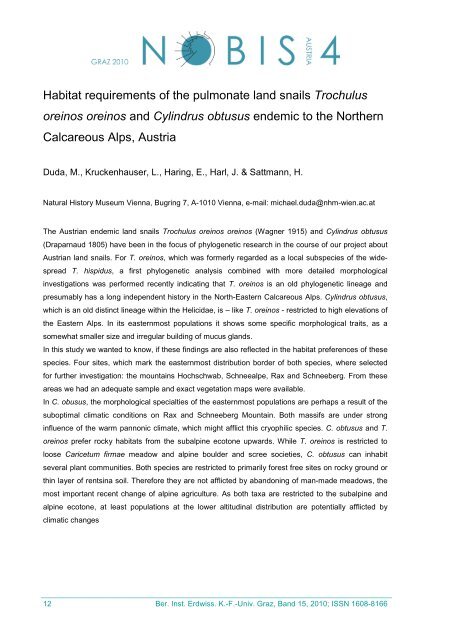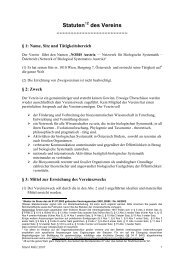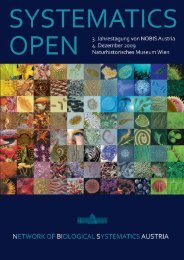4. Jahrestagung von NOBIS Austria 2. - 3. Dezember 2010
4. Jahrestagung von NOBIS Austria 2. - 3. Dezember 2010
4. Jahrestagung von NOBIS Austria 2. - 3. Dezember 2010
Create successful ePaper yourself
Turn your PDF publications into a flip-book with our unique Google optimized e-Paper software.
Habitat requirements of the pulmonate land snails Trochulus<br />
oreinos oreinos and Cylindrus obtusus endemic to the Northern<br />
Calcareous Alps, <strong>Austria</strong><br />
Duda, M., Kruckenhauser, L., Haring, E., Harl, J. & Sattmann, H.<br />
Natural History Museum Vienna, Bugring 7, A-1010 Vienna, e-mail: michael.duda@nhm-wien.ac.at<br />
The <strong>Austria</strong>n endemic land snails Trochulus oreinos oreinos (Wagner 1915) and Cylindrus obtusus<br />
(Draparnaud 1805) have been in the focus of phylogenetic research in the course of our project about<br />
<strong>Austria</strong>n land snails. For T. oreinos, which was formerly regarded as a local subspecies of the wide-<br />
spread T. hispidus, a first phylogenetic analysis combined with more detailed morphological<br />
investigations was performed recently indicating that T. oreinos is an old phylogenetic lineage and<br />
presumably has a long independent history in the North-Eastern Calcareous Alps. Cylindrus obtusus,<br />
which is an old distinct lineage within the Helicidae, is – like T. oreinos - restricted to high elevations of<br />
the Eastern Alps. In its easternmost populations it shows some specific morphological traits, as a<br />
somewhat smaller size and irregular building of mucus glands.<br />
In this study we wanted to know, if these findings are also reflected in the habitat preferences of these<br />
species. Four sites, which mark the easternmost distribution border of both species, where selected<br />
for further investigation: the mountains Hochschwab, Schneealpe, Rax and Schneeberg. From these<br />
areas we had an adequate sample and exact vegetation maps were available.<br />
In C. obusus, the morphological specialties of the easternmost populations are perhaps a result of the<br />
suboptimal climatic conditions on Rax and Schneeberg Mountain. Both massifs are under strong<br />
influence of the warm pannonic climate, which might afflict this cryophilic species. C. obtusus and T.<br />
oreinos prefer rocky habitats from the subalpine ecotone upwards. While T. oreinos is restricted to<br />
loose Caricetum firmae meadow and alpine boulder and scree societies, C. obtusus can inhabit<br />
several plant communities. Both species are restricted to primarily forest free sites on rocky ground or<br />
thin layer of rentsina soil. Therefore they are not afflicted by abandoning of man-made meadows, the<br />
most important recent change of alpine agriculture. As both taxa are restricted to the subalpine and<br />
alpine ecotone, at least populations at the lower altitudinal distribution are potentially afflicted by<br />
climatic changes<br />
_____________________________________________________________________________<br />
12 Ber. Inst. Erdwiss. K.-F.-Univ. Graz, Band 15, <strong>2010</strong>; ISSN 1608-8166






